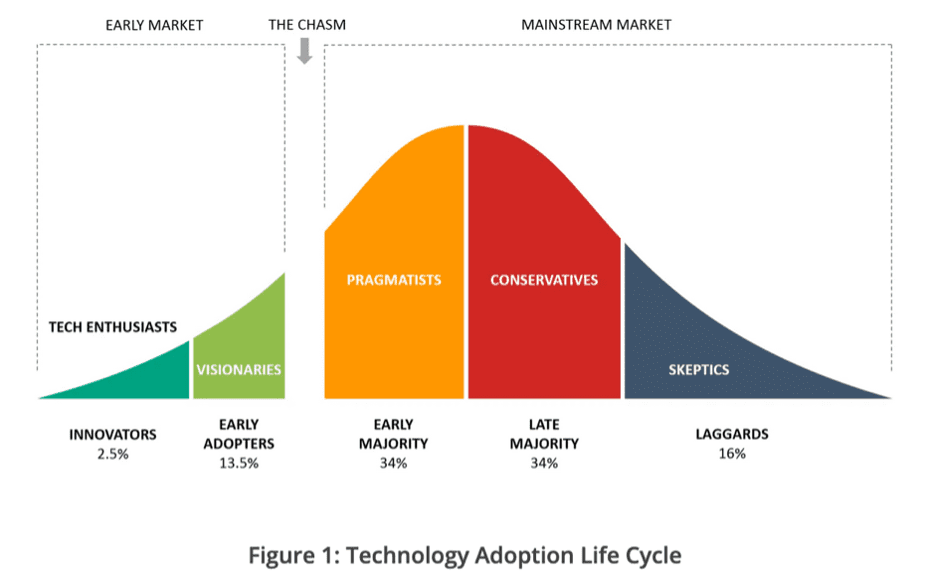American theorist Geoffrey Moore adapted the original Diffusion of Innovation theory to form his Technology Adoption Life Cycle theory. This theory explains how the study of consumer behavior leads to a higher success rate for diffusing technology innovations through the curve. By understanding consumer behavior, marketers can promote their innovations in ways strategically designed to create alignment with each adopter group.
Technology Adoption Life Cycle Theory
Moore’s Technology Adoption Life Cycle theory describes the adoption or acceptance of a new product or innovation according to specific characteristics of defined adopter groups. Moore uses the same bell curve as Everett M. Rogers; however, he renamed the segment groups and identified a separation in the bell curve he labeled “the chasm.” Moore believes that in order to sell a successful technological innovation, marketers must study the behaviors of their target audiences. He classified each user group in the bell curve by understanding their psychological and demographical traits.

The Segments Breakdown: Early Market vs. Mainstream Market
Although Moore uses the original Diffusion of Innovation bell curve, the names of each segment group have been changed to reflect consumer behaviors. The breakdown of each segment group is as follows:
-
Tech Enthusiasts, also referred to as the Innovators, makeup 2.5% of the bell curve and are a part of the Early Market. This group consists of consumers who want to be the first to purchase a new technological invention. Technology is an integral part of their interests. They are more willing to adopt technology innovations than most groups. Tech brands need to appeal to this group because tech enthusiasts help diffuse technological innovations through the curve.
-
Visionaries, also referred to as the Early Adopters, makeup 13.5% of the bell curve and are a part of the Early Market. This group tends to adopt new technology products faster than others. Visionaries are not technology-focused like tech enthusiasts; however, they are looking for products that will have a revolutionary impact on their lives. This segment is willing to pay more for a new invention if it significantly enhances their desired lifestyle. Visionaries do not need approval from other groups to purchase a new product; they rely on their intuition when adopting products. Capturing this group is essential for tech brands because the other segments tend to rely on the Visionaries’ stamp of approval.
-
Pragmatists, also known as the Early Majority, makeup 34% of the bell curve and are a part of the Mainstream Market. This group has similar behaviors as the Visionaries but relies more on practicality. They are more willing to ask questions such as “Is this going to make my life better? Can I afford it?” Pragmatists are more likely to wait and see if a product innovation is all hype or indeed worth buying. They rely more on product reviews before spending money. Since this group makes up a larger part of the bell curve, marketing strategies should always include product reviews and testimonials to prove product capabilities.
-
Conservatives, also known as the Late Majority, makeup 34% of the bell curve and are a part of the Mainstream Market. While this group shares similar behaviors with Pragmatists, they are more conservative when it comes to purchasing products. Conservatives do not crave progressive change, which explains why they only adopt technological innovations once those inventions become the standard. They are unlikely to purchase from smaller brands and will only adopt an innovation if it comes from a well-known organization. Typically, brands that are market leaders prove most successful in appealing to this segment.
-
Skeptics, also known as the Laggards, makeup 16% of the bell curve and are a part of the Mainstream Market. This segment resists new technology because they believe disruptive innovations do not actually fulfill guarantees that are promised. Selling to this demographic should not be a priority for brands; however, listening to their criticism can help brands market or develop their future products.
How to Dominate Each Market and Cross the Chasm
Moore’s idea of crossing the chasm and separating the Early Market from the Mainstream Market makes his Technology Adoption Life Cycle theory stand out. He believes that marketers should appeal to one segment at a time, starting with the tech enthusiasts. As you diffuse through the curve, marketers must adjust and pivot their strategies to appeal to each consumer group. Moore breaks down how to successfully cross the chasm and dominate the markets through these four steps:
Target an attack on a specific market niche.
Study their behaviors, interests, and beliefs. Develop a marketing and positioning strategy that aligns with the psychological and demographical attributes of that particular target audience. Marketers need to understand what motivates each group to buy, as well as understand the competition, pricing, positioning, distribution, and other market factors.
Assemble an invasion force.
The invasion force consists of products and services that fully solve the target audience’s problem. Moore states that this stage is when you create a “whole product,” which consists of the innovation itself and the add-ons that will convince the shopper to buy. Examples of add-ons that make up a whole product include additional software, standards & procedures, training & support, cables, installation & debugging, system integration, and more hardware. This step is essential to fully develop the innovation and product positioning to ensure it stands out when it hits the market.
Define the battle.
To define the battlefield, we have to understand who we are fighting. When releasing new products, marketers need to study the competition to learn how to stand out from the competition. Moore states that competition is healthy and necessary for innovations to succeed. For instance, the Pragmatists rely on competitive products to compare each one before determining what to buy. By studying the competition, marketers can develop authentic, unique positioning statements to stand out from competitors. Prove that you are the market leader by releasing trust signals and proof that validates your claims. (Walk the walk; don’t just talk the talk.)
Launch the invasion.
When it is time to launch the product, marketers need to strategize distribution and pricing. “As we launch our invasion across the chasm, distribution is the vehicle that will carry us on our mission, and pricing is its fuel.” Marketers must secure an optimized channel to launch the product to grab the attention of the early market and the mainstream market. Choosing the right channel—direct sales, retail, OEMs, selling partnerships, outbound retail, etc.—that aligns with the target niche is key to crossing the chasm. Customer-oriented pricing models keep the consumers’ best interest in mind, especially those at the end of the curve. However, there are also vendor-oriented pricing and distribution-oriented pricing models, each one with its pros and cons. When going to market, marketers have to choose the correct mix of distribution and pricing to pave the way for the innovation’s success.
Crossing the chasm and appealing to the Early Majority are the most challenging parts of Moore’s theory. Converting the Early Majority and the groups after requires more planning, product positioning, and brand strategy. When a brand has obtained adoption from the five consumer segments, then it has dominated the curve.
Studying Consumer Behavior in Order to Increase Brand Adoption
Moore understands that brands must do more than release product innovations to disrupt the market. Marketers need to learn the psychological and demographical attributes of each segment in order to market products correctly and diffuse them through the curve.
At IDealogic®, we research your target audiences’ psychological and demographical behaviors and engineer strategies based on that data to help your business garner brand and product adoption. If you want your brand to dominate the curve, schedule an introduction call with us to learn how we can help.



